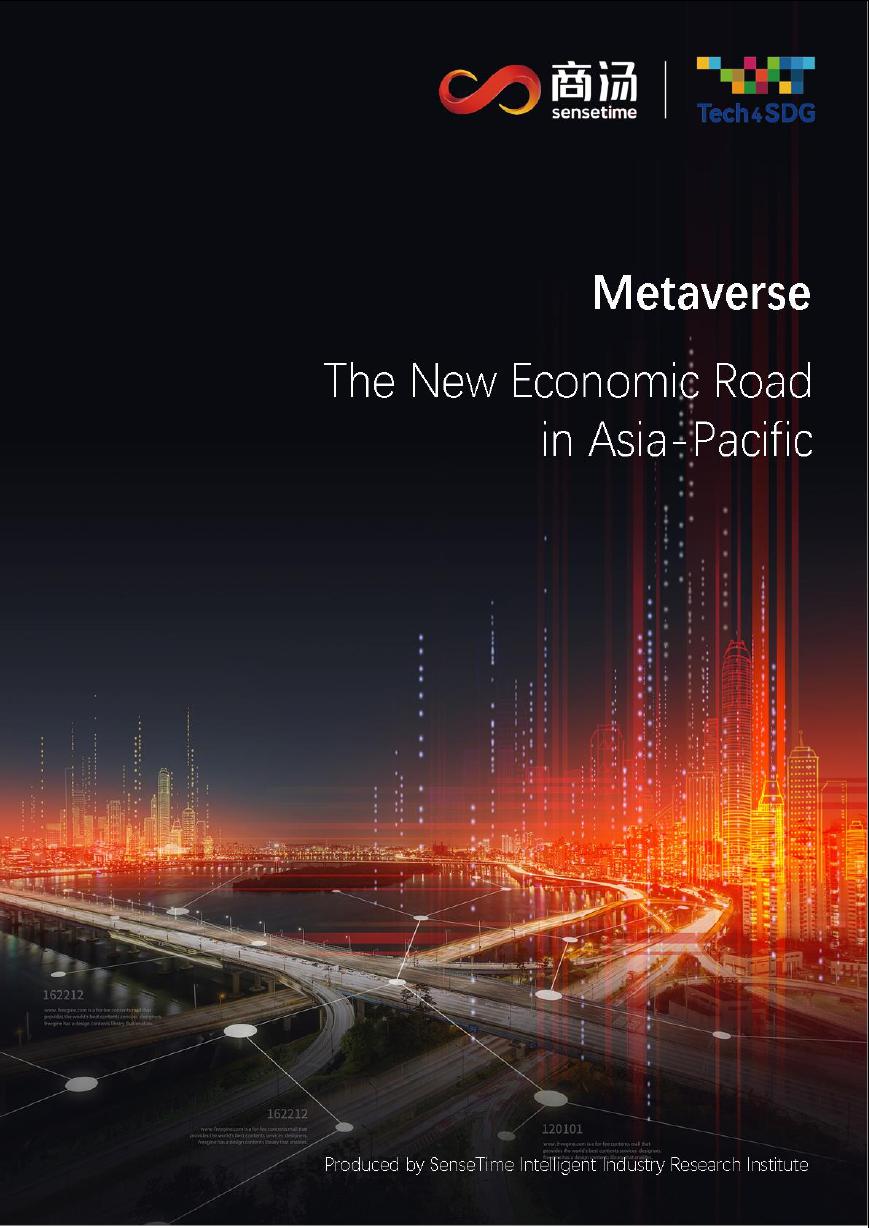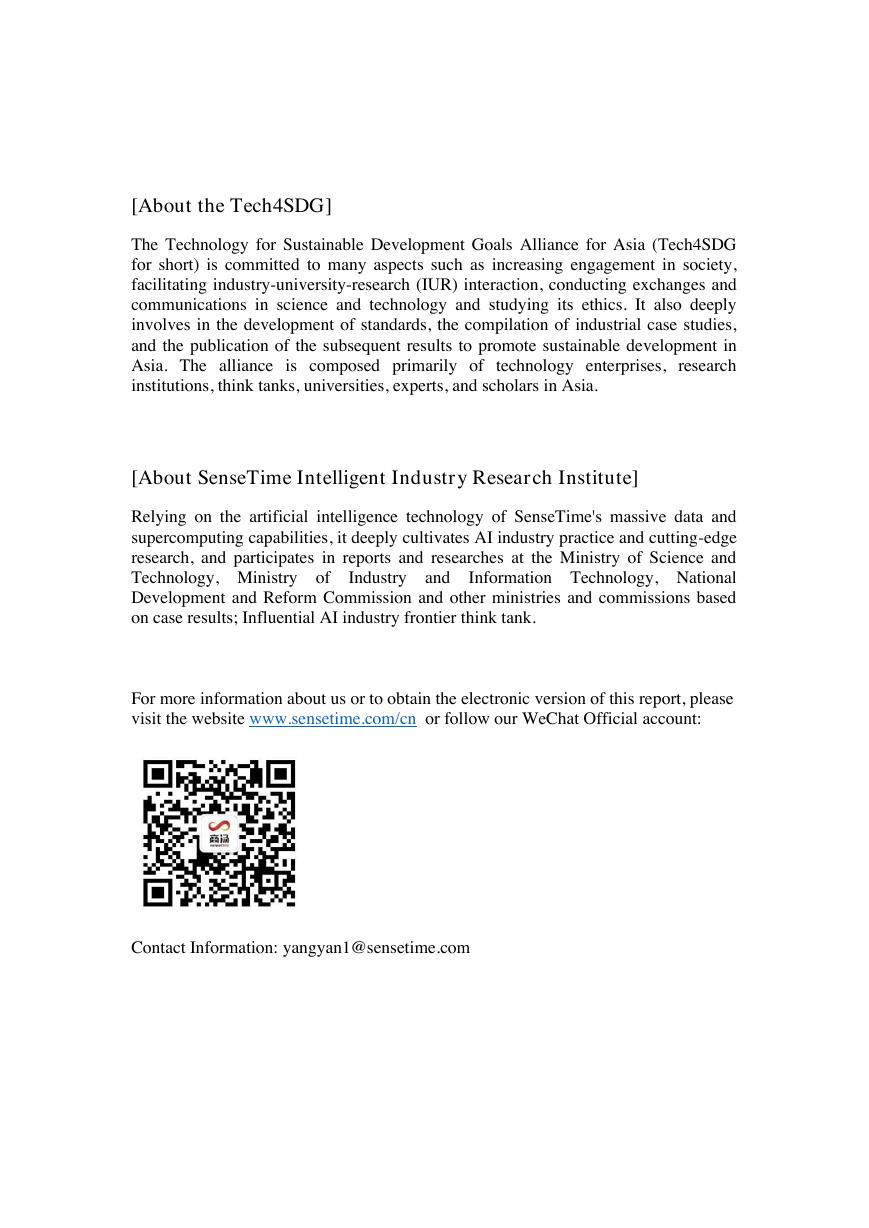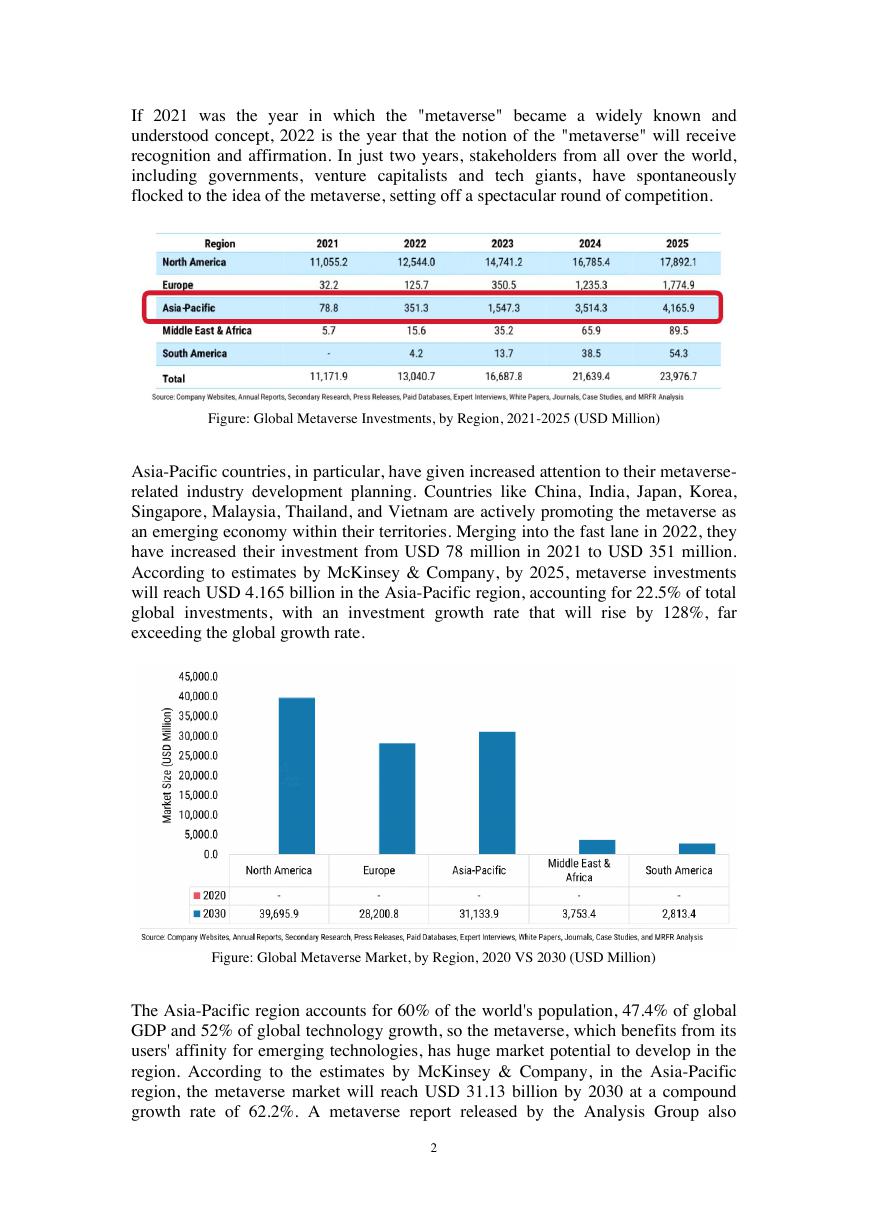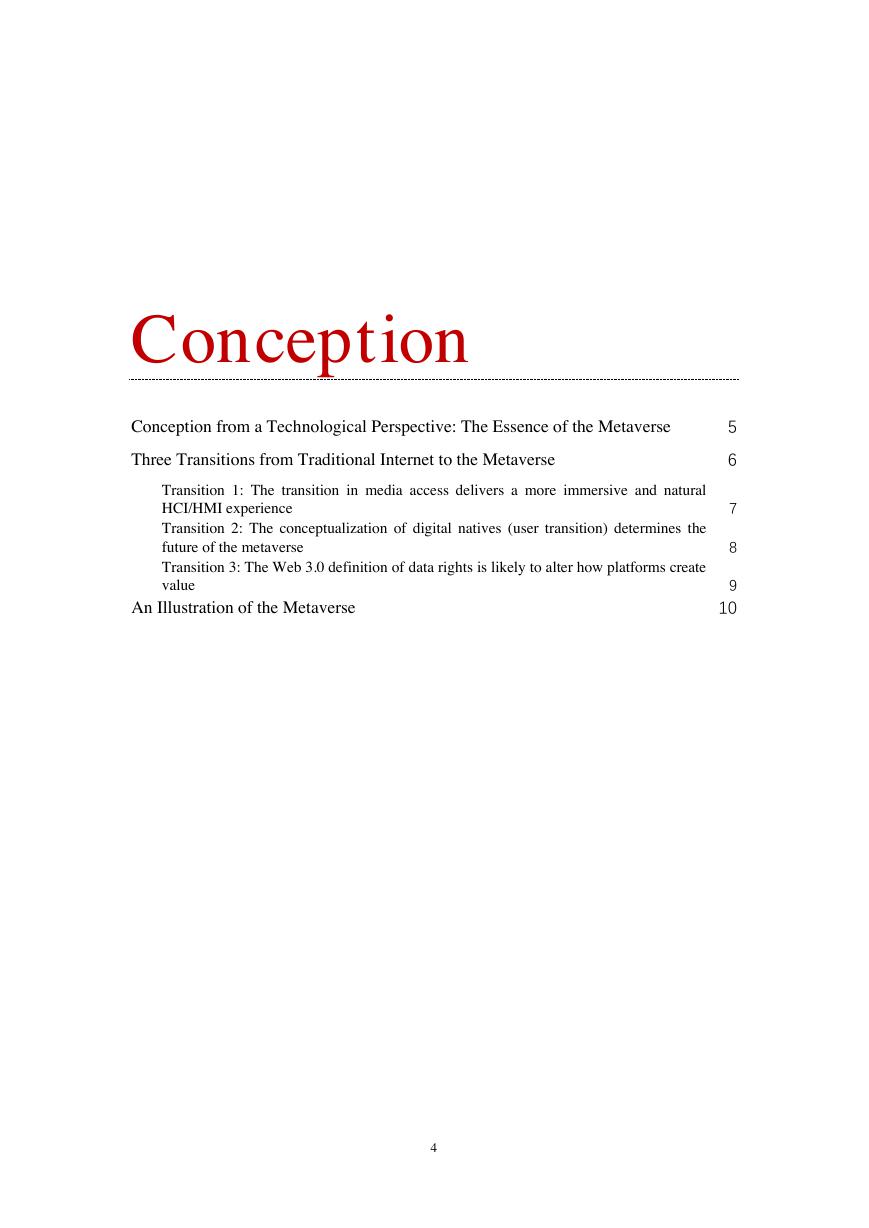�
[About the Tech4SDG]
The Technology for Sustainable Development Goals Alliance for Asia (Tech4SDG
for short) is committed to many aspects such as increasing engagement in society,
facilitating industry-university-research (IUR) interaction, conducting exchanges and
communications in science and technology and studying its ethics. It also deeply
involves in the development of standards, the compilation of industrial case studies,
and the publication of the subsequent results to promote sustainable development in
Asia. The alliance is composed primarily of technology enterprises, research
institutions, think tanks, universities, experts, and scholars in Asia.
[About SenseTime Intelligent Industry Research Institute]
Relying on the artificial intelligence technology of SenseTime's massive data and
supercomputing capabilities, it deeply cultivates AI industry practice and cutting-edge
research, and participates in reports and researches at the Ministry of Science and
Technology, Ministry of
Information Technology, National
Development and Reform Commission and other ministries and commissions based
on case results; Influential AI industry frontier think tank.
For more information about us or to obtain the electronic version of this report, please
visit the website www.sensetime.com/cn or follow our WeChat Official account:
Industry and
Contact Information: yangyan1@sensetime.com
Contents
Foreword
Conception
Conception from a Technological Perspective: The Essence of the Metaverse
Three Transitions from Traditional Internet to the Metaverse
Transition 1: The transition in media access delivers a more immersive and natural
HCI/HMI experience
Transition 2: The conceptualization of digital natives (user transition) determines
the future of the metaverse
Transition 3: The Web 3.0 definition of data rights is likely to alter how platforms
create value
An Illustration of the Metaverse
Creation
Three Forces Integrating Virtuality with Reality that Create the Metaverse
Creativity: Accelerating the creation of the virtual world
Connectivity: Realizing the connection between digital and physical worlds
Integration: Pushing the integration of virtuality and reality and intelligent
development of the metaverse
The Three Infrastructures that Consolidate Metaverse Productivity
Engine: A low-threshold and cross-terminal creation environment
Algorithm: Accelerating "creation," achieving "connection" and promoting
"integration"
Computing power: Supporting the massive computation of the metaverse
Empowerment
SenseMARS Mixed Reality Platform: Engine Infrastructure that Creates and
Designs the Metaverse
SenseMARS Avatar: "We/us" in the metaverse
SenseMARS Agent: "They/them" in the metaverse
SenseMARS Reconstruction: Digital reconstruction of the physical world
SenseCore Universal AI Platform: Supporting the algorithms and computing
power infrastructure of the metaverse
Cases
Case 1: Asia's "unmanned" help desk created by AEON
Case 2: Zepeto - Custom avatars through rapid face molding
I
1
4
5
6
7
8
9
10
12
13
13
13
14
14
14
15
15
16
17
18
19
19
20
22
23
25
�
Case 3: AR Navigation at Suvarnabhumi Airport, Thailand
Case 4: Watching games via AR interaction in a Japanese baseball stadium
Case 5: Riyadh Season's immersive AR journey
Case 6: Schwarzkopf - AR hair-dyeing trial
Case 7: AR Digital cultural and creative platform
Epilogue
25
27
28
31
32
33
II
�
Foreword
1
�
If 2021 was the year in which the "metaverse" became a widely known and
understood concept, 2022 is the year that the notion of the "metaverse" will receive
recognition and affirmation. In just two years, stakeholders from all over the world,
including governments, venture capitalists and tech giants, have spontaneously
flocked to the idea of the metaverse, setting off a spectacular round of competition.
Figure: Global Metaverse Investments, by Region, 2021-2025 (USD Million)
Asia-Pacific countries, in particular, have given increased attention to their metaverse-
related industry development planning. Countries like China, India, Japan, Korea,
Singapore, Malaysia, Thailand, and Vietnam are actively promoting the metaverse as
an emerging economy within their territories. Merging into the fast lane in 2022, they
have increased their investment from USD 78 million in 2021 to USD 351 million.
According to estimates by McKinsey & Company, by 2025, metaverse investments
will reach USD 4.165 billion in the Asia-Pacific region, accounting for 22.5% of total
global investments, with an investment growth rate that will rise by 128%, far
exceeding the global growth rate.
Figure: Global Metaverse Market, by Region, 2020 VS 2030 (USD Million)
The Asia-Pacific region accounts for 60% of the world's population, 47.4% of global
GDP and 52% of global technology growth, so the metaverse, which benefits from its
users' affinity for emerging technologies, has huge market potential to develop in the
region. According to the estimates by McKinsey & Company, in the Asia-Pacific
region, the metaverse market will reach USD 31.13 billion by 2030 at a compound
growth rate of 62.2%. A metaverse report released by the Analysis Group also
2
�
indicated that metaverse technology will contribute USD 3 trillion to global GDP over
the next ten years, a third of which (i.e., USD 1 trillion) will come from the Asia-
Pacific region. In other words, over the next ten years, every US dollar invested in the
metaverse industry will bring about an economic growth of USD 3.16, a return on
investment of over 300%.
So, what is the metaverse? How is a metaverse world created? As an AI software
company, how should SenseTime empower the creation and development of the
metaverse, both in the Asia-Pacific region and throughout the whole world? The
White Paper "Metaverse: The New Economic Road in Asia-Pacific" centers around
four chapters encompassing the conception, the creation, and the empowerment of the
metaverse, and specific cases to give all a glimpse into this newly emerging cyber
world.
3
�
Conception
Conception from a Technological Perspective: The Essence of the Metaverse
Three Transitions from Traditional Internet to the Metaverse
Transition 1: The transition in media access delivers a more immersive and natural
HCI/HMI experience
Transition 2: The conceptualization of digital natives (user transition) determines the
future of the metaverse
Transition 3: The Web 3.0 definition of data rights is likely to alter how platforms create
value
An Illustration of the Metaverse
5
6
7
8
9
10
4
�
















 V2版本原理图(Capacitive-Fingerprint-Reader-Schematic_V2).pdf
V2版本原理图(Capacitive-Fingerprint-Reader-Schematic_V2).pdf 摄像头工作原理.doc
摄像头工作原理.doc VL53L0X简要说明(En.FLVL53L00216).pdf
VL53L0X简要说明(En.FLVL53L00216).pdf 原理图(DVK720-Schematic).pdf
原理图(DVK720-Schematic).pdf 原理图(Pico-Clock-Green-Schdoc).pdf
原理图(Pico-Clock-Green-Schdoc).pdf 原理图(RS485-CAN-HAT-B-schematic).pdf
原理图(RS485-CAN-HAT-B-schematic).pdf File:SIM7500_SIM7600_SIM7800 Series_SSL_Application Note_V2.00.pdf
File:SIM7500_SIM7600_SIM7800 Series_SSL_Application Note_V2.00.pdf ADS1263(Ads1262).pdf
ADS1263(Ads1262).pdf 原理图(Open429Z-D-Schematic).pdf
原理图(Open429Z-D-Schematic).pdf 用户手册(Capacitive_Fingerprint_Reader_User_Manual_CN).pdf
用户手册(Capacitive_Fingerprint_Reader_User_Manual_CN).pdf CY7C68013A(英文版)(CY7C68013A).pdf
CY7C68013A(英文版)(CY7C68013A).pdf TechnicalReference_Dem.pdf
TechnicalReference_Dem.pdf